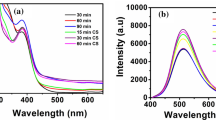Abstract
The actual incorporation of dopant species into the ZnS Quantum Dots (QDs) host lattice will induce structural defects evidenced by a red shift in the corresponding exciton. The doping should create new intermediate energetic levels between the valence and conduction bands of the ZnS and affect the electron-hole recombination. These trap states would favour the energy transfer processes involved with the generation of cytotoxic radicals, so-called Reactive Oxygen Species, opening the possibility to apply these nanomaterials in cancer research. Any synthesis approach should consider the direct formation of the QDs in biocompatible medium. Accordingly, the present work addresses the microwave-assisted aqueous synthesis of pure and doped ZnS QDs. As-synthesized quantum dots were fully characterized on a structural, morphological and optical viewpoint. UV-Vis analyzes evidenced the excitonic peaks at approximately 310 nm, 314 nm and 315 nm for ZnS, Cu-ZnS and Mn-ZnS, respectively, Cu/Zn and Mn/Zn molar ratio was 0.05%. This indicates the actual incorporation of the dopant species into the host lattice. In addition, the Photoluminescence spectrum of non-doped ZnS nanoparticles showed a high emission peak that was red shifted when Mn2+ or Cu2+ were added during the synthesis process. The main emission peak of non-doped ZnS, Cu-doped ZnS and Mn-doped ZnS were observed at 438 nm, 487 nm and 521 nm, respectively. Forthcoming work will address the capacity of pure and Cu-, Mn-ZnS quantum dots to generate cytotoxic Reactive Oxygen Species for cancer treatment applications.
Similar content being viewed by others
References
C. Rosiles-Perez et al., “Luminescent Cd1–xZnxS quantum dots synthesized by a nanoemulsion method, assisted by an ultrasonic probe,” J. Lumin., vol. 184, pp. 123–129, 2017.
B. Achakpa Ikyo, “Electron-Hole and Photon Recombination Processes in Quantum Well Semiconductor Lasers,” Am. J. Opt. Photonics, vol. 3, no. 5, p. 80, 2015.
S. Bailón-Ruiz and O. J. Perales-Pérez, “Generation of singlet oxygen by water-stable CdSe(S) and ZnSe(S) quantum dots,” Appl. Mater. Today, vol. 9, pp. 161–166, 2017.
G. Drummen, Drummen, and G. P.C., “Quantum Dots—From Synthesis to Applications in Biomedicine and Life Sciences,” Int. J. Mol. Sci., vol. 11, no. 1, pp. 154–163, Jan. 2010.
X. Dai et al., “Solution-processed, high-performance light-emitting diodes based on quantum dots,” Nature, vol. 515, p. 96, Oct. 2014.
S. J. Bailón-Ruiz, “Processing of Zn-Based Quantum Dots as Potential Photo-Sensitizers for Nanomedicine Applications.,” 2013.
D. Trachootham et al., “Selective killing of oncogenically transformed cells through a ROS-mediated mechanism by β-phenylethyl isothiocyanate,” Cancer Cell, vol. 10, no. 3, pp. 241–252, 2006.
A. C. S. Samia, X. Chen, and C. Burda, “Semiconductor Quantum Dots for Photodynamic Therapy,” J. Am. Chem. Soc., vol. 125, no. 51, pp. 15736–15737, Dec. 2003.
I. B. Bwatanglang et al., “Folic acid targeted Mn:ZnS quantum dots for theranostic applications of cancer cell imaging and therapy,” Int. J. Nanomedicine, vol. 11, pp. 413–428, Jan. 2016.
T.-T. Xuan, J.-Q. Liu, R.-J. Xie, H.-L. Li, and Z. Sun, “Microwave-Assisted Synthesis of CdS/ZnS:Cu Quantum Dots for White Light-Emitting Diodes with High Color Rendition,” Chem. Mater., vol. 27, no. 4, pp. 1187–1193, Feb. 2015.
J. Blaškovičová et al., “Detection of ROS Generated by UV-C Irradiation of CdS Quantum Dots and their Effect on Damage to Chromosomal and Plasmid DNA,” Electroanalysis, vol. 30, no. 4, pp. 698–704, Dec. 2017.
J.-J. Shi, L. Gong, Y.-H. Zhang, P. Yang, and J. He, “Microwave-assisted sonochemical synthesis of Cu and Mn doped GSH–ZnS polypeptide quantum dots and their enhanced photoelectrochemical properties,” RSC Adv., vol. 6, no. 111, pp. 109386–109393, 2016.
W. Q. Peng, G. W. Cong, S. C. Qu, and Z. G. Wang, “Synthesis and photoluminescence of ZnS:Cu nanoparticles,” Opt. Mater. (Amst)., vol. 29, no. 2–3, pp. 313–317, 2006.
I. Nanoclusters, “OPTICAL CHARACTERIZATION OF ZINC SULPHIDE (ZnS).”
C. Angelé-Martínez, K. V. T. Nguyen, F. S. Ameer, J. N. Anker, and J. L. Brumaghim, “Reactive oxygen species generation by copper(II) oxide nanoparticles determined by DNA damage assays and EPR spectroscopy,” Nanotoxicology, vol. 11, no. 2, pp. 278–288, Feb. 2017.
M. Dubey, “SYNTHESIS , STRUCTURAL AND OPTICAL CHARACTERIZATION OF CdS NANOPARTICLES,” Lab Man. Phys. Chem., vol. 6, no. 1, pp. 57–62, 2010.
Author information
Authors and Affiliations
Rights and permissions
About this article
Cite this article
Rivera, J.A., Bailón-Ruiz, S.J. & Perales-Perez, O.J. One-step Aqueous Synthesis of Zn-based Quantum Dots as Potential Generators of Reactive Oxygen Species. MRS Advances 4, 399–404 (2019). https://doi.org/10.1557/adv.2019.27
Published:
Issue Date:
DOI: https://doi.org/10.1557/adv.2019.27



